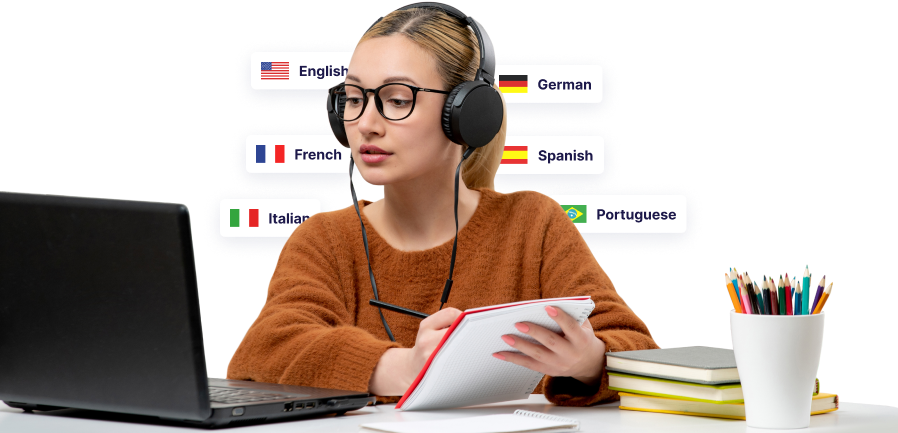Rapid Translate Team
E-commerce has proved a powerful tool for businesses to expand their global reach. However, one factor that limits this expansion is the language gap between cultures and countries. Luckily, e-commerce translation makes online content available to different language speakers.
This action ensures that various audiences find products and services that meet their needs. This blog post explores the role of translations in e-commerce. It also provides the strategies and best practices for using this service to enhance user experience (UX).
Read to the end to understand the details about translating e-commerce content!

Table of Contents
What Is E-Commerce Translation?
E-commerce translation is the process of changing all the content on an e-commerce website into another language. This includes user reviews, product descriptions, payment instructions, and navigation menus. This enables users speaking different languages to easily access and enjoy the website and its content.
Translating e-commerce content is crucial for businesses to extend their reach into international markets. This action helps create a smooth online shopping experience for customers worldwide. High-quality website translations are an effective way to increase engagement, trust, and international sales.
However, this type of translation goes beyond changing texts from one language to another. It involves adapting the content to suit the target market’s cultural preferences, differences, and systems. In the language industry, this means providing localized content to enhance user experience.

Key Components of Translation for E-Commerce
While various e-commerce websites seem basic, several elements work together to make it so. These elements are the major components of document translations for global businesses. They help to boost user experience in various locations. These components include:
- Product descriptions: Translating descriptions of various products is vital for informing potential buyers. Adapting these descriptions to the target language makes the content culturally relevant for the customer. It uses the specific terms that make the product perfect for the local market.
- User interface features: The translated e-commerce website must have features suitable for different languages. This includes translated menus, button texts, and navigation options. This part requires that every element fit within the right space, regardless of the language.
- Legal compliance: This ensures that the localized content meets the local market’s legal standards, privacy policies, and terms of service. Accurate translations are crucial to ensure everyone complies with the legal standards.
- Technical elements: This involves adjusting sizes, symbols, weights, units of measure, and currency to the local system.
- Cultural elements: This part involves changing content, rules, and beliefs that may not apply to the target culture.
- Marketing and SEO content: This involves translating blog posts, advertising materials, and product promotions. It also covers changing keywords and tags to improve the site for search engines in the target language. This part involves keyword research in different languages to ensure better visibility and reach.
- Customer support: Translations also involve providing customer service in multiple languages. This is useful for increasing customer satisfaction in different locations. In addition are translations for FAQ, support documents, and chatbots.

7 Strategies To Use E-Commerce Translation Services
To effectively impact global markets, you need to apply some strategies. These strategies apply to various aspects of your business, including how you use e-commerce translation services.
We’ve highlighted these seven strategies for you in this section.
1. Understand the Target Market
Research your target market to understand consumer behavior, preferred products, online shopping habits, and preferred payment methods. Once you have all this information, change the content to suit their needs and preferences.
This content should also align with their local values, customs, and traditions. This is the perfect way to ensure the message feels natural to market consumers.
2. Focus on High-Impact Content
Start your translation with the most important pages, such as top marketing materials, product descriptions, and customer support pages. Also, create a plan for accurate and quick translations of content that changes regularly.
3. Combine Machine Translation With Human Efforts
Combine machine translation tools with human reviews to balance productivity with accuracy. Use translation tools to translate bulk content and edit it using human translation services.
You can use translation management systems to save previously translated content and get consistent results. A few top ones, like Smartling, Lokalise, and Phrase, work for e-commerce.
4. Adopt Local SEO Practices
Translate and localize keywords according to your target market’s search behavior. This includes meta descriptions, tags, and other SEO elements. Create content that satisfies your audience’s needs and interests to improve search engine rankings.
5. Collaborate With Local Experts
Partner with local experts to review your translations and ensure they meet local and legal standards. Work with local influencers to gain knowledge about the market.
6. Plan for Growth
Design your content to allow easy updates and growth. This is especially important for sites with frequently changing promotions and product listings. Develop a strategy that allows the smooth addition of new markets and languages as your brand expands.
7. Provide Customer Support in Multiple Languages
Provide customer support in various languages to improve user experience. This covers areas like email support, live chat, and phone support. Also, train your customer support team on common questions and local customs in the location.

Best Practices for Translating E-Commerce Content
Let’s look at the best practices to maintain the quality of your translations:
- Use professional translation services: Using the services of professional human translators with expertise in e-commerce ensures accurate translations. Additionally, ensure they know market trends, local languages, and cultural differences.
- Use a localized approach: Use localization translation to adjust suitable content for your local market. This includes images, payment options, units and measurements, slogans, shipping policies, and SEO content.
- Maintain consistent branding: Your brand should always have a consistent voice, message, and tone across all languages. This includes consistent translation across mobile apps, websites, social platforms, and other resources.
- Regular testing: Regularly test your content to identify what each market likes. Gather and analyze customer feedback to adjust your translated content and strategy.
- Comply with local rules: Translate legal documents like privacy policies, terms and conditions, and return policies. This ensures that your e-commerce website complies with the local laws and consumer rights.
- Regularly update content: Review and update translated content to ensure your content suits consumer preferences.
- Adjust marketing campaigns: Create suitable marketing translations for your local audiences based on their language and cultural qualities. You should also translate and adapt your social media content for users in different regions.
FAQ
Now that we’ve covered how to apply translation for e-commerce in your business, let’s answer some frequently asked questions!
What is ecommerce translation?
Translation for e-commerce involves converting online sales content from one language to another. This process ensures your message is culturally relevant to native speakers in your target market.
Should I localize my whole e-commerce website or just specific pages?
This action depends on your resources and target market. Nonetheless, localizing the entire website is best for a complete user experience. However, you can start with high-impact areas if you have limited resources. These areas are more likely to attract your international customers.
How does translation occur in e-commerce?
Translation in e-commerce occurs through an organized process to change content to your target customer’s native languages. The process involves identifying and extracting content, translating and localizing it, and reviewing it.
After this, the next step is to use and integrate the content and regularly update and maintain it. All of this happens while paying attention to the target market’s legal, cultural, and technical qualities.
Need a Professional E-Commerce Translation Agency? Go For Rapid Translate
Translating and localizing your e-commerce content is helpful for your brand to reach a global audience. However, achieving this is impossible without the services of a professional e-commerce translation agency. A translation agency uses the services of language experts in your industry to provide high-quality results.
Apart from translating content from the source language, Rapid Translate makes it culturally appropriate for your target audience. We provide exactly this quality of service for businesses around the world. Our service covers various business materials that can boost international sales.
In addition, we localize your content to build loyalty and trust among your target customers. Make Rapid Translate your first choice if you need the best e-commerce translation solutions.





